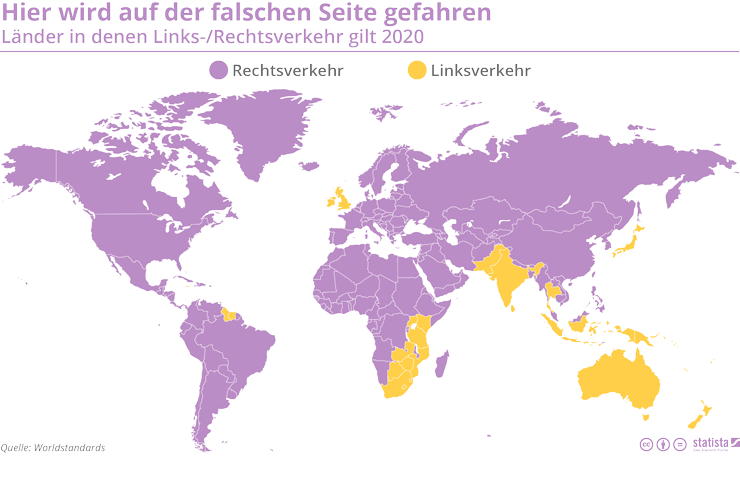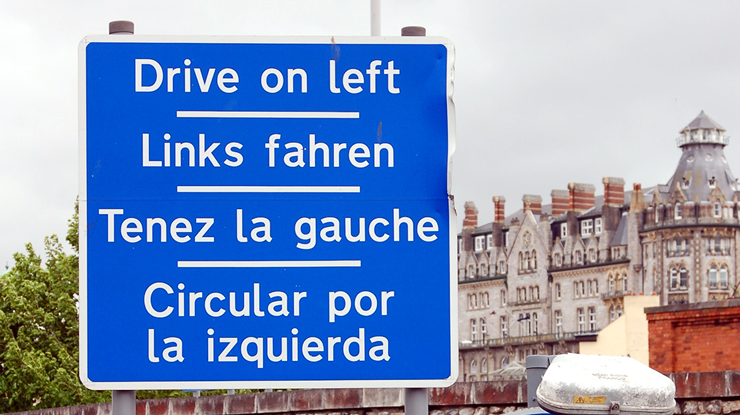Countries with left-hand traffic: How travellers can prepare themselves
Anyone who has been driving on the right-hand side of the road for years faces challenges when driving in the UK or other left-hand traffic countries. As a result, some people immediately decide against a holiday in such regions - or at least avoid driving there themselves.
The good news is that with a little practice and the right preparation, the "change to the left" is practically a piece of cake, according to the experience of motor vehicle and insurance expert Alexander Held from Verti Versicherung AG.
"Suddenly switching from the usual right-hand lane to the opposite lane can be intimidating, especially at the beginning. However, this should not be a reason to forego a holiday with a car or motorhome in countries like England, Australia or Malta," thinks Alexander Held. After all, there is left-hand traffic in almost 60 countries worldwide.
His tip for the start: "Even if your own car is more familiar - for the beginning you are best advised to hire a car. Because that way you're steering a car that was also built for left-hand traffic - with the steering wheel on the right. The good news is that the pedals for the clutch, brake and accelerator are in the same order in both types of vehicle - so there's no danger of confusing the accelerator and brake.
A rental car with automatic transmission is helpful at the beginning
The gearstick lever is also in the middle, just like in left-hand drive cars. However, this means that drivers who are used to shifting gears with their right hand have to adjust: "If you have the opportunity, it is therefore best to rent a car with automatic transmission. Alternatively, you can practise shifting gears shortly before your first drive to get used to the still unfamiliar grip. It also helps to do a few test laps on a test track or to cover the first few metres on a stretch of road with little traffic," advises expert Held.
In left-hand traffic, overtake on the right, of course
In addition, a navigation system makes it easier to drive in left-hand traffic, as the driver does not have to pay as much attention to place-name signs and road signs. "Planning your route in advance can also be helpful and avoid unnecessary stress while driving." Stressful situations are likely to include overtaking in particular: "In left-hand traffic, people naturally overtake on the right. But attention is also needed in right-turn lanes, so that after turning you don't accidentally steer your car onto the wrong side of the road out of sheer habit." Turning left, on the other hand, is less critical because the oncoming lane is not crossed.
The "left before right" rule does not exist
Alexander Held cites roundabouts as a particular challenge: "The flow of traffic is clockwise in countries with left-hand traffic. In England's roundabouts without traffic lights, those coming from the right always have the right of way," reports the motor vehicle expert. If there are several lanes, the left-hand ones are reserved for those who want to take the first exit. Those taking a middle exit stay in the middle and those taking a late exit stay in the far right lane. "As in Germany, it is of course best to head for the right lane straight away. Exiting the roundabout is to the left and should definitely be indicated with timely flashing lights."
Alexander Held räumt auch mit einem weit verbreiteten Missverständnis auf: „Was man nicht einfach umdrehen kann, ist die hierzulande bekannte Regel „rechts vor links“. Es gibt kein entsprechendes „links vor rechts“!“ In England beispielsweise seien an Kreuzungen vielmehr eindeutige Schilder oder Markierungen auf der Straße, die die Vorfahrt regeln. In Australien dagegen finde trotz Linksverkehr die Vorfahrtsregel „rechts vor links“ Anwendung, sofern die Vorfahrt nicht durch ein „Give way“-Schild, „Stop“-Schild oder eine Ampel geregelt sei.
List of countries with left-hand traffic
Afrika: Botswana, Kenya, Lesotho, Malawi, Mauritius, Mozambique, Namibia (right-hand traffic until 1915), Zambia, Seychelles, Zimbabwe, South Africa, Eswatini, Tanzania, Uganda.
America: American Virgin Islands, Anguilla, Antigua and Barbuda, Bahamas, Bermuda, Barbados, British Virgin Islands, Dominica, Grenada, Jamaica, Cayman Islands, Montserrat, St. Kitts and Nevis, St. Lucia, St. Vincent and the Grenadines, Trinidad and Tobago, Guyana, Falkland Islands, Suriname, in Bolivia exclusively on the Yungas Strait, otherwise right-hand traffic.
Asia: Bangladesh, Bhutan, Brunei, Hong Kong, India, Indonesia, Japan, Macau, Malaysia, Maldives, Nepal, East Timor, Pakistan, Singapore, Sri Lanka, Thailand, Cyprus (incl. Northern Cyprus).
Europe: United Kingdom, Ireland, Isle of Man, Guernsey, Jersey, Malta, Republic of Cyprus.

Accidents in left-hand traffic are more likely to happen on the left side of the road
It is also important to know that most accidents when switching to left-hand traffic happen on the left side of the vehicle, i.e. away from the driver. "What many people don't know, in fact: Those who are used to driving on the right often tend to keep too little distance to the left side, at least initially - they are simply not used to so many cars on their left," Alexander Held explains. "An attentive co-driver is therefore a good help at the beginning - because he should make himself known in good time when things get tight."
Not falling into the old habit of driving on the right-hand side of the road is also important for insurance reasons. The Regional Court of Mainz, for example, ruled that motor vehicle insurance cover can be lost if the accident occurs because the driver uses the right-hand side of the road in left-hand traffic. The behaviour was classified by the court as grossly negligent, so that the comprehensive insurance of the person driving in the accident did not have to pay for damages (Ref. 7 O 391/97).
 © gemlea, AdobeStock
© gemlea, AdobeStock
Why there is left-hand traffic
Even in the Middle Ages, long before automobiles populated the streets, there were rules and laws about which side of the road carriages had to drive on. There are various legends about the origin of left-hand traffic. One possible theory is based on the majority of right-handers. Since people in the past as well as today preferred to mount horses - or today bicycles and motorbikes - from the left, they were safer on the left-hand side of the road and protected from the passing traffic. In addition, riders could greet each other by holding out their right hand when they met.
According to another derivation, the left-hand traffic prevalent at the time may have evolved from shipping. The starboard of the British was usually mounted on the right. It was not until Napoleon's campaigns of conquest and later the spread of the automobile in the early 20th century that more and more countries changed their traffic regulations to the right. Nevertheless, today 59 countries drive on the left, mostly in former British colonies, but also in Thailand, Japan and small island states such as Bermuda.
The majority of left-hand driving countries are former British colonies such as Australia, India and South Africa, which have retained the occupiers' road rules. Some Asian countries, such as Japan among others, also prefer the left-hand side of the road. In Europe, there are only four states with left-hand driving regulations: Great Britain, Ireland, Malta and Cyprus.

